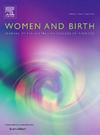Barriers and facilitators for implementation of continuity of midwife care: A review of reviews
IF 4.4
2区 医学
Q1 NURSING
引用次数: 0
Abstract
Background
Continuity of Midwife Care (CoMC) significantly improves maternal and neonatal outcomes, including reducing mortality. However, global implementation remains limited, hindered by various barriers and facilitators across healthcare settings. This review of reviews synthesizes existing evidence on barriers and facilitators to CoMC implementation using the Consolidated Framework for Implementation Research (CFIR) as an analytical tool.
Methods
Following the Joanna Briggs Institute (JBI) methodology, a review of reviews was conducted. Comprehensive searches of Embase, Medline, CINAHL, and grey literature identified reviews published between 2013 and 2024 that addressed CoMC implementation. Data were categorized by CFIR 2.0 domains: innovation characteristics, outer setting, inner setting, characteristics of individuals, and implementation processes.
Results
Six reviews met inclusion criteria. Barriers to CoMC were systemic and included hierarchical power dynamics, limited midwife autonomy, workforce shortages, and inadequate policy support. Facilitators were more context-specific, influenced by healthcare infrastructure and resources. Key facilitators included supportive leadership, collaborative care models, and national guidelines promoting CoMC.
Conclusion
Barriers to CoMC are deeply embedded in healthcare systems, while facilitators are highly dependent on local contexts. Bridging the evidence-practice gap requires applying implementation science methodologies, such as CFIR, to inform policy and intervention strategies. Collaboration between countries with similar healthcare systems can foster knowledge-sharing and adaptation of successful CoMC models. These findings offer actionable insights for policymakers and healthcare professionals to advance CoMC integration globally.
求助全文
约1分钟内获得全文
求助全文
来源期刊

Women and Birth
NURSING-OBSTETRICS & GYNECOLOGY
CiteScore
7.20
自引率
13.20%
发文量
371
审稿时长
27 days
期刊介绍:
Women and Birth is the official journal of the Australian College of Midwives (ACM). It is a midwifery journal that publishes on all matters that affect women and birth, from pre-conceptual counselling, through pregnancy, birth, and the first six weeks postnatal. All papers accepted will draw from and contribute to the relevant contemporary research, policy and/or theoretical literature. We seek research papers, quality assurances papers (with ethical approval) discussion papers, clinical practice papers, case studies and original literature reviews.
Our women-centred focus is inclusive of the family, fetus and newborn, both well and sick, and covers both healthy and complex pregnancies and births. The journal seeks papers that take a woman-centred focus on maternity services, epidemiology, primary health care, reproductive psycho/physiology, midwifery practice, theory, research, education, management and leadership. We also seek relevant papers on maternal mental health and neonatal well-being, natural and complementary therapies, local, national and international policy, management, politics, economics and societal and cultural issues as they affect childbearing women and their families. Topics may include, where appropriate, neonatal care, child and family health, women’s health, related to pregnancy, birth and the postpartum, including lactation. Interprofessional papers relevant to midwifery are welcome. Articles are double blind peer-reviewed, primarily by experts in the field of the submitted work.
 求助内容:
求助内容: 应助结果提醒方式:
应助结果提醒方式:


